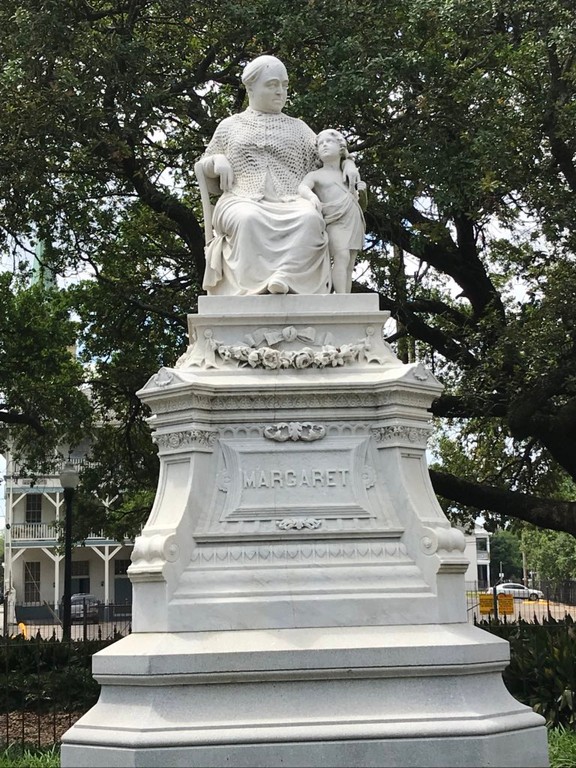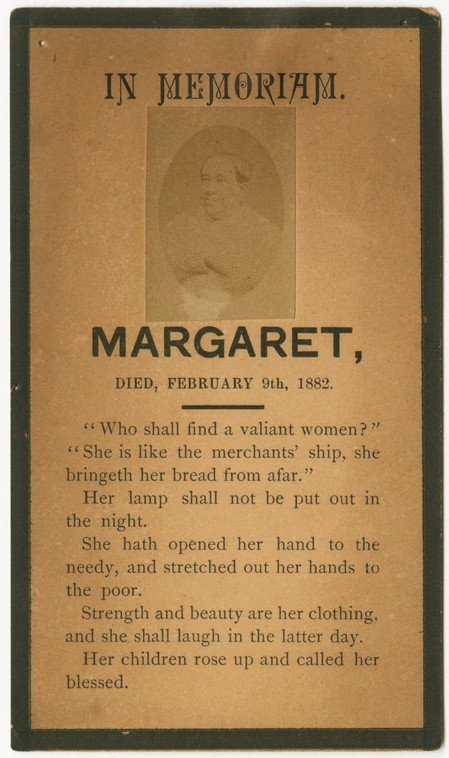Margaret Haughery Statue
Introduction
Text-to-speech Audio
Images

Portrait by Jacques Guillaume Lucien


Margaret Haughery memorial card

Backstory and Context
Text-to-speech Audio
Margaret (Gaffney) Haughery was born in Tully, Carrigallen County, Leitrim, Ireland in 1813. While in Ireland her family lived in poverty. When she was five years old, she moved with her parents and two out of five siblings to Baltimore, Maryland. Tragedy struck Margaret young when both of her parents passed away in 1822 from yellow fever. Orphaned at the age of nine, A young woman took her in a required that Margaret worked to earn her keep. This would lead her to a life of domestic service. In 1835, Margaret married Charles Haughery and moved to New Orleans one month later.
Margaret and Charles had a daughter named Frances. Two years later, tragedy strikes Margaret again twice in a short period of time. Her husband falls ill and goes back to his home country of Ireland to recover. A short time after his arrival he passes away. A few months after her husband’s death, her only child Frances dies. Margaret’s new station in life as an Irish immigrant and window was not good. There was still a prejudice about Irish immigrants in the Antebellum south. To support herself, she worked as a laundress at the St. Charles Hotel. During this time, she stayed at the Sisters of Charity in exchange for volunteer work. She would work at the hotel and beg for food and cash donations. Any extra money she had to spare she donated to the Sisters of Charity. Eventually due to their kindness, Margaret was able to save enough money to buy two dairy cows to provide milk to the orphans. This develops into a dairy farm of over forty cows and a prosperous dairy business. She grew her business further by purchasing a mule-drawn cart and making deliveries. This success allowed her to contribute more to the construction of a new larger orphanage for the Sisters of Charity. Along with her dairy business, Margaret helped D’Aquin Bakery pay off numerous loans which gave her collateral stock in the bakery. In 1859 she became the majority owner in the nearly bankrupt bakery. She turned D’Aquin’s Bakery into Margaret’s Steam and Mechanical Bakery. It was one of the earliest steam bakeries in the South and survived beyond the Civil War. She employed up to forty men and was the largest bakery in the United States at one point. Her flour depot was capable of manufacturing 800 barrels of flour per day in addition to what she needed to make her own products. She would donate free bread and products to orphanages and women’s homes throughout New Orleans. She would never turn away a person in need.
Margaret Haughery was the second woman in the United States to have a statue erected in her honor. The citizens of New Orleans commissioned a statue of her likeness soon after her death in 1882. The statue was sculpted by Andrew Doyle using Italian marble. It has stood since 1884 in the Lower Garden District.
Controversy surrounds Margaret even though she has a reputation as a successful businesswoman and philanthropist. Her charitable activities stretched beyond the needy women and children of New Orleans. She was known to have donated money to a white supremacist organization, the Crescent City White League, that terrorized African American residents and for a brief period overthrew the state government. This event was considered a turning point in the Reconstruction Era. Margaret also donated goods to the White League in the immediate aftermath of the September 14, 1874 attack on the Metropolitan Police in downtown New Orleans. This attack was known as the Battle of Liberty Place. Another point of contention is that Margaret ran the advertisements for her bakery through the Daily Democrat newspaper in the 1870s and early 80s. The editor of the Daily Democrat was a Confederate Veteran who once called for the extermination of African Americans. She also contributed to a fund for the ten orphaned children of former Confederate General John Bell Hood who died of yellow fever.
Upon her death Margaret donated all of her estate and funds. She donated $13,000 to six different orphanages and two asylums for widows, or mothers with dependent children. She also paid off the debts of Elizabeth’s House of Industry and left the remaining amount, up to $30,000 to the Sisters of Charity with instructions that it be used to maintain St. Vincent’s infant Asylum.
In the second decade of the 21st century, the decision to honor prominent Americans who supported the Confederacy and white supremacist organizations during Reconstruction and the era of segregation has led to debates about the propriety of such statues in public spaces such as parks. However, even though Margaret Haughery was a financial supporter of the Crescent City White League, a white supremacist paramilitary organization that targeted African American families and overthrew the legally elected biracial government through force during Reconstruction, there has been little debate about removing this statue as of December 2020.
Sources
Luck, Adrienne. Margaret Haughery: “Friend of the Orphans”, New Orleans Historical. Accessed November 19th 2020. https://neworleanshistorical.org/items/show/477.
Margaret Haughery, The Historic New Orleans Collection. Accessed November 19th 2020. https://www.hnoc.org/virtual/voices-progress/margaret-haughery.
Karst, James. Margaret Haughery: Friend of orphans -- and of white supremacist militia, Nola. March 25th 2018. Accessed November 19th 2020. https://www.nola.com/entertainment_life/vintage/article_091cd9f2-4743-5eb7-94b7-20bd1055ac13.html.
Margaret Haughery Statue, Wander Women Project. Accessed November 19th 2020. https://wanderwomenproject.com/places/margaret-haughery-statue/.
Kelley, Laura D. Margaret Haughery, 64 Parishes. Accessed November 19th 2020. https://64parishes.org/entry/margaret-haughery.
Gehman, Mary. Margaret Haughery Statue, Chopin Web. Accessed November 19th 2020. http://people.loyno.edu/~kchopin/Album13.html.
https://en.wikipedia.org/wiki/Margaret_Haughery
https://64parishes.org/entry/margaret-haughery
http://people.loyno.edu/~kchopin/Album13.html
https://www.hnoc.org/virtual/voices-progress/margaret-haughery
